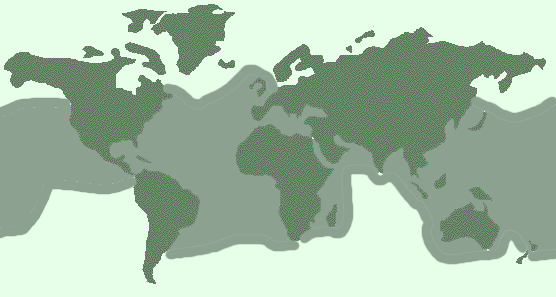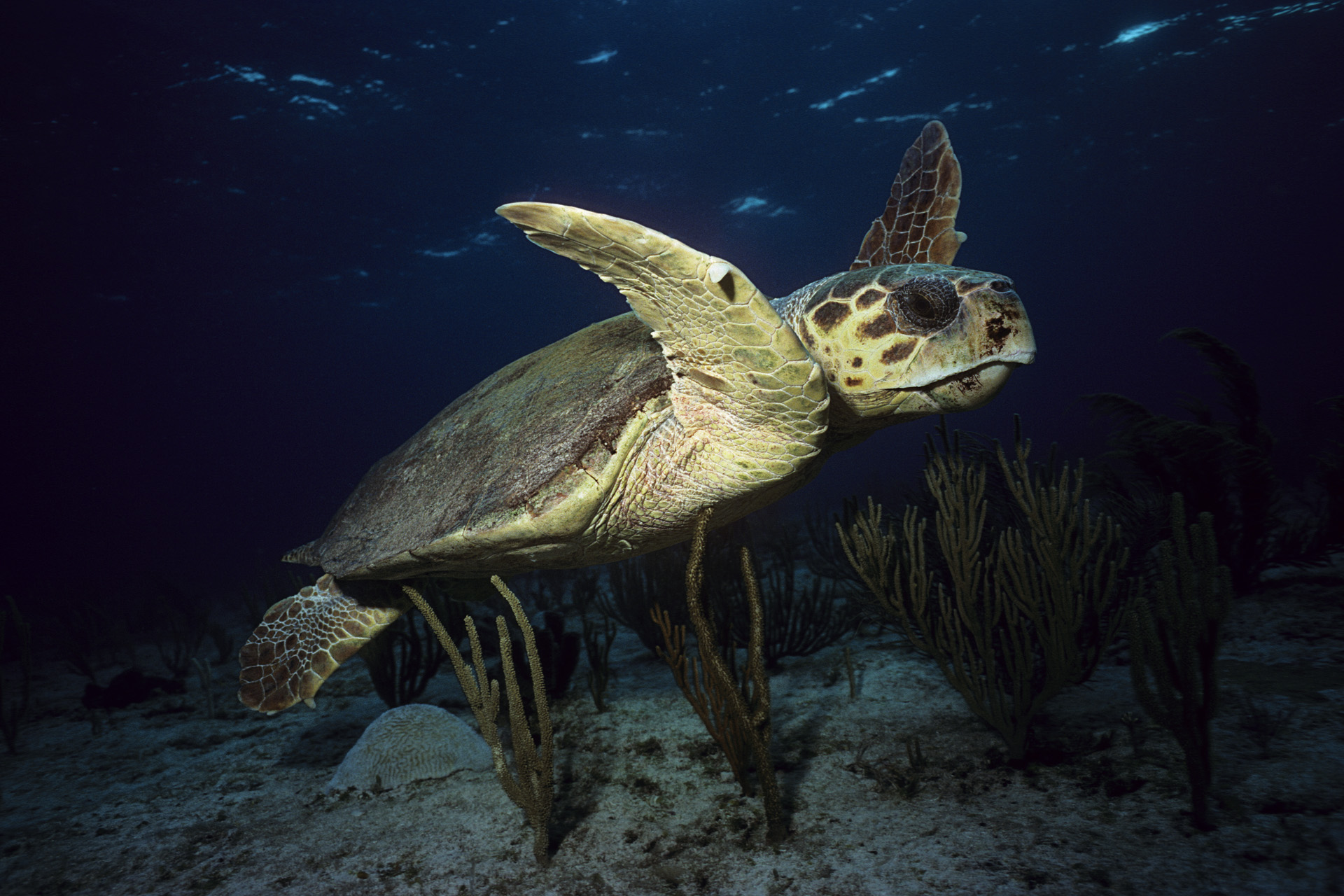Habitat and Geography
The Caretta caretta, also known as the loggerhead sea turtles is
widely distributed all over the world in coastal waters, subtropical
waters, and temperate waters of the Atlantic, Pacific, and Indian
Oceans. The primary habitat of loggerheads is in southeastern United
States, South America, and the western parts of the Atlantic,
Mediterranean, and Indian Oceans (MarineBio, 2014; U.S. Fish &
Wildlife Service, 2013; Hawkes et al., 2011; Karavas et al., 2006).
Most of the nesting concentrations in the U.S. are found from
southwest Florida to North Carolina. The Archie Carr National
Wildlife Refuge is found in Florida and is an important nesting area
for loggerhead turtles in the western hemisphere (NOAA, 2013).
Little nesting takes place westward to Texas up to
Virginia. When female loggerheads from U.S. beaches are not nesting,
they can be found in eastern U.S., Greater Antilles, Bahamas, Gulf
of Mexico and Yucatán waters. Nearly 88% of loggerhead nesting
around the entire world is found in the U.S., Oman, and Australia
(NOAA, 2013). Take a look at the loggerhead distribution map below.
The widely distributed loggerheads live in thre e ecosystems during
their life time: beaches (terrestrial zone), water (oceanic zone),
and near shore coastal areas (“neritic” zone) (NOAA, 2013).
Examples of near shore coastal areas are bays, salt marshes,
lagoons, creeks, and the mouths of large rivers. Other
examples of where a loggerhead may be found are coral reefs and
rocky places (U.S.
Fish & Wildlife, 2013). Loggerheads face many threats in their
habitat. A main threat in a loggerhead habitat is getting caught in
fishing gear (NOAA, 2013). Examples of predators that live in a
loggerhead hatchling’s habitat on beaches are
sea birds, mammals,
crabs and carnivorous fish (MarineBio, 2014). To learn more about
the loggerhead’s prey and predators
click here.
e ecosystems during
their life time: beaches (terrestrial zone), water (oceanic zone),
and near shore coastal areas (“neritic” zone) (NOAA, 2013).
Examples of near shore coastal areas are bays, salt marshes,
lagoons, creeks, and the mouths of large rivers. Other
examples of where a loggerhead may be found are coral reefs and
rocky places (U.S.
Fish & Wildlife, 2013). Loggerheads face many threats in their
habitat. A main threat in a loggerhead habitat is getting caught in
fishing gear (NOAA, 2013). Examples of predators that live in a
loggerhead hatchling’s habitat on beaches are
sea birds, mammals,
crabs and carnivorous fish (MarineBio, 2014). To learn more about
the loggerhead’s prey and predators
click here.
The loggerhead’s habitats on beaches or along bays need to be on
sand for nesting (U.S. Fish and Wildlife Service, 2013). The
loggerhead habitats on beaches are usually steep, narrow,
and have suitable sand (NOAA, 2013). Suitable sand, or the sand
texture, is an important characteristic that loggerheads look for in
selecting a beach. Suitable sand allows for exchange, is moist,
allows water to be drained from the nest, and prevents from the nest
from collapsing onto the eggs (Karavas et al., 2006). Sand on the coast has a high pH, low nutrient content, and a high
concentration of salt (Karavas et al., 2006).The Caretta caretta's
nesting site is usually located with other species of sea turtles
(U.S. Fish and Wildlife, 2013). Once a loggerhead hatches, usually
at night, it follows the light reflected off the water to the sea
(MarineBio, 2014). When the hatchlings make it to the sea, they can
be found in ocean currents floating on buildups of material like
seaweed (NOAA, 2013). Loggerhead hatchlings from the United States
are believed to live in the ocean currents (the North Atlantic
gyre) for 7 to 12 years (U.S. Fish and Wildlife, 2013). Once the
hatchling grows to a certain size, the juvenile loggerheads migrate
to inshore areas such as lagoons, estuaries, bays, river mouths, and
shallow coastal waters (U.S. Fish and Wildlife, 2013; NOAA, 2013).
The juveniles mature inshore for 13 to 20 years before making their
first reproductive migration (U.S. Fish and Wildlife, 2013). To learn
about loggerhead reproduction
click here.
The females may have a long migration back to their origin al birth place to nest (NOAA, 2013; U.S. Fish and Wildlife Service, 2013;
MarineBio, 2014). An adult female loggerhead migrates on a seasonal pattern may also have a wintering area. A wintering
area is where some loggerheads rest in water just warm enough for
survival (Hawkes et al., 2011). Wito their nesting beaches,
coastal feeding grounds, water or deep sea areas, and temperate
areas. The loggerheadnter home ranges were on average
smaller than summer home ranges according to population studied by
Hawkes et al., (2011). Also, according to the population studied by
Hawkes et al., loggerhead turtles are likely to be found in
the same home ranges year after year (2011). A loggerhead's typical habitat, according to a subpopulation studied by Hawkes
et al., is unlikely to be found at temperatures lower than
18.2 degrees Celsius or higher than 29.2 degrees Celsius (2011). It is also unlikely to be found in waters where the current is more than
50 cm per second. The loggerhead habitat is usually in depths between 3.0
meters and 89.0 meters (Hawkes et al., 2011).
al birth place to nest (NOAA, 2013; U.S. Fish and Wildlife Service, 2013;
MarineBio, 2014). An adult female loggerhead migrates on a seasonal pattern may also have a wintering area. A wintering
area is where some loggerheads rest in water just warm enough for
survival (Hawkes et al., 2011). Wito their nesting beaches,
coastal feeding grounds, water or deep sea areas, and temperate
areas. The loggerheadnter home ranges were on average
smaller than summer home ranges according to population studied by
Hawkes et al., (2011). Also, according to the population studied by
Hawkes et al., loggerhead turtles are likely to be found in
the same home ranges year after year (2011). A loggerhead's typical habitat, according to a subpopulation studied by Hawkes
et al., is unlikely to be found at temperatures lower than
18.2 degrees Celsius or higher than 29.2 degrees Celsius (2011). It is also unlikely to be found in waters where the current is more than
50 cm per second. The loggerhead habitat is usually in depths between 3.0
meters and 89.0 meters (Hawkes et al., 2011).
Link
Form and Function→